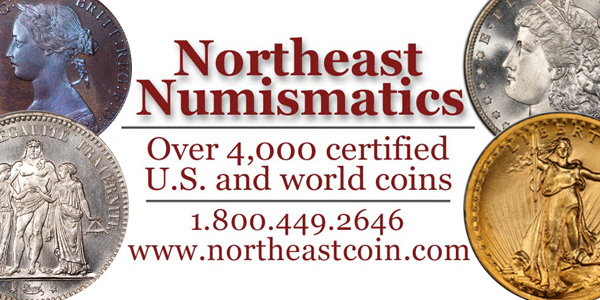
PREV ARTICLE
NEXT ARTICLE
FULL ISSUE
PREV FULL ISSUE
VOCABULARY TERMS: CABINET MEDALDick Johnson submitted these entries from his Encyclopedia of Coin and Medal Terminology. Thanks. -Editor Cabinet Medal. One of a group of small portrait medals issued by the United States Mint in the mid 19th century. The first bore a portrait of George Washington and the inscription "A Memorial of the Washington Cabinet May 1859." Most are slightly larger than a dime – numismatically a medalet – bear portraits of Washington, Jackson, Lincoln, Grant and Garfield, were frequently muled, and some were still available in the 20th century as list medals. The vast popularity for Washington medals prior to the Civil War led U.S. Mint Director James Ross Snowden to issue two Washington medals, a subject close to his interest, as he was the author of a book on Washington medals and he built an exhibit of these in a vacant room in the U.S. Mint building in Philadelphia. The first was a small medal mentioned above; the second bore a Houdon inspired portrait on the obverse, and an exhibit case surmounted by a bust of Washington on the reverse (PR-23). Snowden's chicanery in his mint position has been well documented. He had restruck early U.S. coins from dies still in the mint, and traded these copies to numismatists of the time for specimens he wanted for the mint collection. While criticized for this activity, he was, however, allowed to issue medals at the mint by his own authority. Thus came into existence the two Washington medals he instigated, the smallest of which was the forerunner of a series of medalets called “cabinet medals.” (The "cabinet" in this term refers to the furniture which held the medal collection in the mint's exhibit room – and not the cabinet of the president's department chiefs.) Snowden's successor, Mint Director James Pollock, who came into office May 1861, continued issuing small portrait medal issues. He resurrected an 1833 Andrew Jackson portrait (if it hadn't already been ordered by Snowden) and Mint Engraver Anthony C. Paquet copied the Jackson portrait for a new cabinet medal. Pollock introduced a twist by muleing the Jackson portrait with one of Washington to create still another variety to sell to the public. A Lincoln medal was added to the series in 1864 and this was quickly muled with Washington. In all, five presidents were portrayed, Washington was muled with all but Garfield; Lincoln was muled with all but Jackson. Die varieties exist of these cabinet medals, particularly the Lincoln pieces, as dies broke and were replaced. At first, cabinet medals were issued in silver with a few in gold. Most were 19mm in diameter – the size of the bronze cent – easy to blank probably with cent blanking dies and easy to strike, all with existing mint equipment. Bronze cabinet medals were not struck until after 1869 according to Robert Julian who researched the U.S. Mint records extensively for his monumental work, Medals of the United States Mint; The First Century, 1792-1892 (see pages 97-108). Many of the cabinet medals – bronze, silver or gold – were ordered by private citizens; some by incumbent or former mint officials; others struck for "over-the-counter" sale to the public. Demand for the small presidential portrait medalets rose with events of the day, and Lincoln's assassination brought a flurry of interest for his medallic memorials, as was U.S. Grant's inauguration March 4, 1869. The 1876 Centennial Exposition in Philadelphia climaxed the demand for these pieces, and even though Garfield's medal was added in 1881 (with a Lincoln mule) demand had peaked, and none created after this date. In the 20th century eleven of these cabinet medals were offered as List Medals (List numbers 601 through 616; 604 is Snowden's large Washington Cabinet Medal; number 605, 610, 613-14 are not in this series). This series was phased out in the 1980s, no cabinet medals are currently offered. Still these medalets of presidents was a forerunner of the large presidential medal series still active a century later. The early cabinet medals must have been a delight for jewelers, who mounted the tiny medals as charms, in frames, bezels, even encased in watch cases covered with glass (watch crystal mounting). Infrequently these come on the market today, still in such 19th century mountings. References:
Looking for the meaning of a numismatic word, or the description of a term? Try the Newman Numismatic Portal's Numismatic Dictionary at: https://nnp.wustl.edu/library/dictionary Or if you would like a printed copy of the complete Encyclopedia, it is available. There are 1,854 terms, on 678 pages, in The Encyclopedia of Coin and Medal Technology. Even running two a week would require more than 19 years to publish them all. If you would like an advance draft of this vital reference work it may be obtained from the author for your check of $50 sent postpaid. Dick Johnson, 139 Thompson Drive, Torrington, CT 06790.  Wayne Homren, Editor The Numismatic Bibliomania Society is a non-profit organization promoting numismatic literature. See our web site at coinbooks.org. To submit items for publication in The E-Sylum, write to the Editor at this address: whomren@gmail.com To subscribe go to: https://my.binhost.com/lists/listinfo/esylum All Rights Reserved. NBS Home Page Contact the NBS webmaster 
|